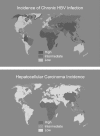Hepatitis B virus and hepatocellular carcinoma
- PMID: 11454100
- PMCID: PMC2517704
- DOI: 10.1111/j.1365-2613.2001.iep0082-0077-x
Hepatitis B virus and hepatocellular carcinoma
Abstract
Chronic hepatitis B virus (HBV) infection is a major global cause of hepatocellular carcinoma (HCC). Individuals who are chronic carriers have a greater than 100-fold increased relative risk of developing the tumour. Several mechanisms of HBV-induced HCC have been proposed. Integration of HBV DNA into the genome of hepatocytes occurs commonly, although integration at cellular sites that are important for regulation of hepatocyte proliferation appears to be a rare event. Functions of the HBx protein are also potentially oncogenic. These include transcriptional activation of cellular growth regulatory genes, modulation of apoptosis and inhibition of nucleotide excision repair of damaged cellular DNA. The effects of HBx are mediated by interaction with cellular proteins and activation of cell signalling pathways. Variations in HBV genome sequences may be important in hepatocarcinogenesis, although their significance has not yet been completely elucidated. Necroinflammatory hepatic disease, which often accompanies chronic HBV infection, may contribute indirectly to hepatocyte transformation in a number of ways, including by facilitating HBV DNA integration, predisposing to the acquisition of cellular mutations and generating mutagenic oxygen reactive species. Although HCC is a malignancy with a poor prognosis, the availability of an effective vaccine against HBV infection, and its inclusion in the Expanded Programme of Immunization of many countries, augurs well for the eventual elimination of HBV-associated HCC.
Figures



References
-
- Ackerman Z, Wands JR, Gazitt Y, Brechot C, Kew MC, Shouval D. Enhancement of HBsAg detection in serum of patients with chronic liver disease following removal of circulating immune complexes. J. Hepatol. 1994;20:398–404. - PubMed
-
- Alka S, Hemlata D, Vaishali C, Shahid J, Kumar PS. Hepatitis B virus surface (S) transactivator with DNA-binding properties. J. Med. Virol. 2000;61:1–10. - PubMed
-
- Arbuthnot P, Capovilla A, Kew MC. Putative role of hepatitis B virus X protein in hepatocarcinogenesis. effects on apoptosis, DNA repair, mitogen-activated protein kinase and JAK/STAT pathways. J. Gastroenerol. Hepatol. 2000;15:357–368. - PubMed
-
- Arii M, Takada S, Koike K. Identification of three essential regions of hepatitis B virus X protein for trans-activation function. Oncogene. 1992;7:397–403. - PubMed
Publication types
MeSH terms
Substances
LinkOut - more resources
Full Text Sources
Medical

